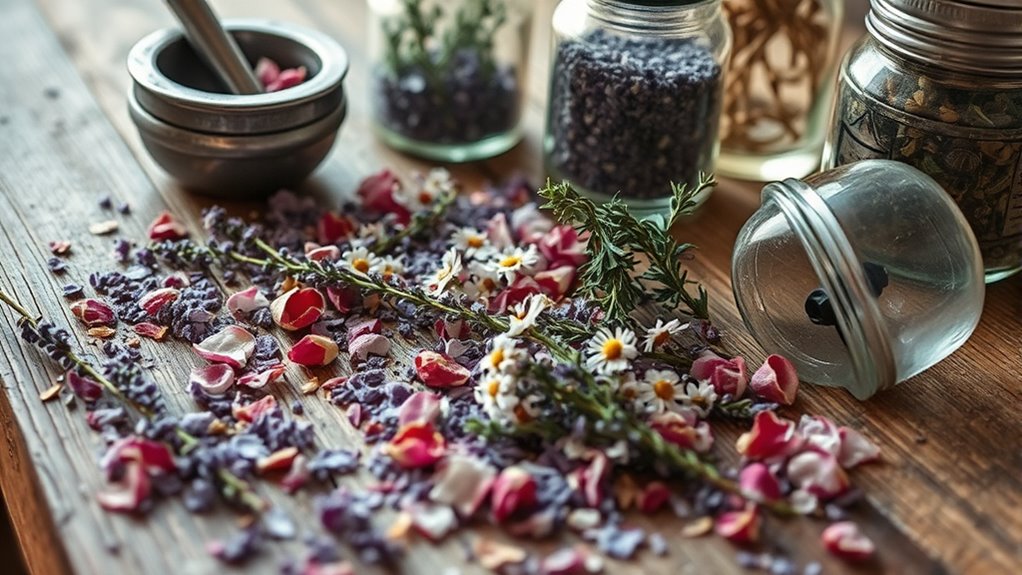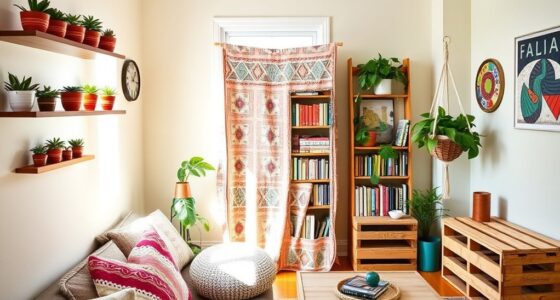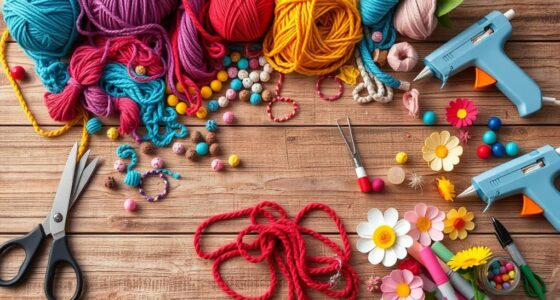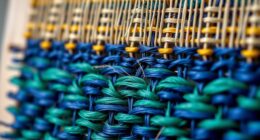In herbal alchemy, you gather fresh herbs and flowers at their peak, then carefully dry them using techniques like air drying or silica gel. Tools like scissors, jars, and drying racks help with your craft. You can create infusions, potpourri, or decorative arrangements, combining your dried botanicals thoughtfully. Proper storage in airtight containers keeps your creations vibrant and fragrant. To master each step and learn tips for lasting results, explore the detailed methods behind crafting with dried herbs and flowers.
Key Takeaways
- Harvest herbs and flowers at peak freshness, handling them carefully and storing in breathable containers away from sunlight.
- Use appropriate drying methods like air drying, oven drying, or silica gel for delicate blooms to preserve color and aroma.
- Create infusions, tinctures, potpourri, or arrangements by combining dried botanicals with oils, alcohol, or fragrant materials for personalized products.
- Incorporate herbs into candles, soaps, and salves using dried or infused botanicals to enhance scent, aesthetic, and therapeutic effects.
- Store finished herbal products in airtight, labeled containers in cool, dark environments, regularly checking for freshness and scent quality.
Gathering and Preparing Your Botanical Materials
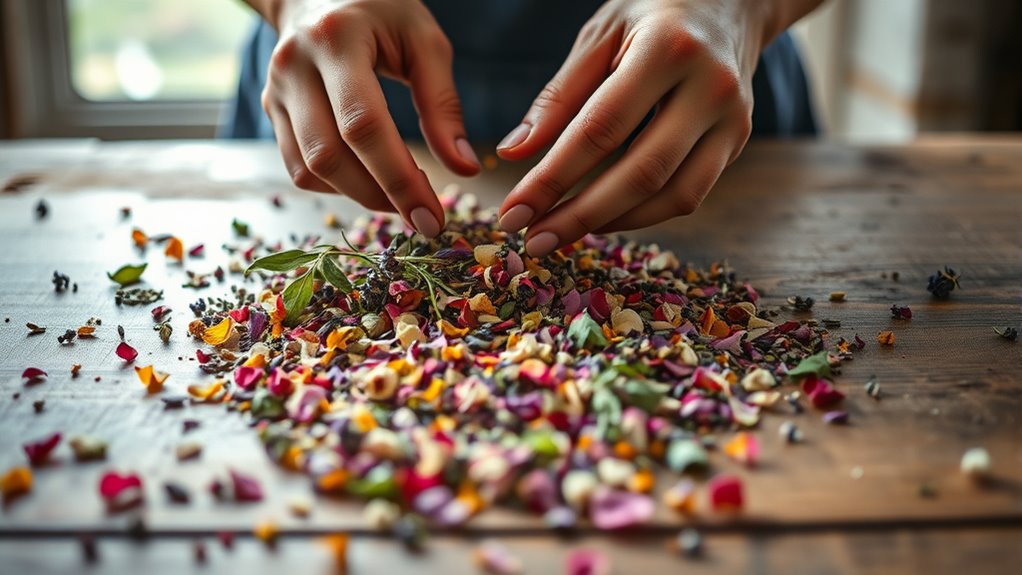
Before you start crafting with dried herbs and flowers, gathering fresh botanical materials at their peak is vital. Botanical harvesting ensures you collect herbs and blooms when their flavors, aromas, and medicinal properties are strongest. Choose healthy, vibrant plants free from pests or damage. Use clean tools to cut stems at the right time—usually in the morning after dew has dried. Once harvested, proper herbal storage is essential to preserve their qualities before drying. Keep your botanicals in breathable containers, away from direct sunlight and moisture, to maintain freshness. Handling your plants carefully during harvesting and storing helps retain their potency and fragrance. This careful preparation sets a solid foundation for successful drying and crafting later on. Additionally, understanding the importance of color accuracy can help ensure your dried herbs retain their vivid hues and visual appeal during processing. Maintaining proper herb quality throughout the process is crucial to achieving the best results in your herbal crafts.
The Art of Drying Herbs and Flowers
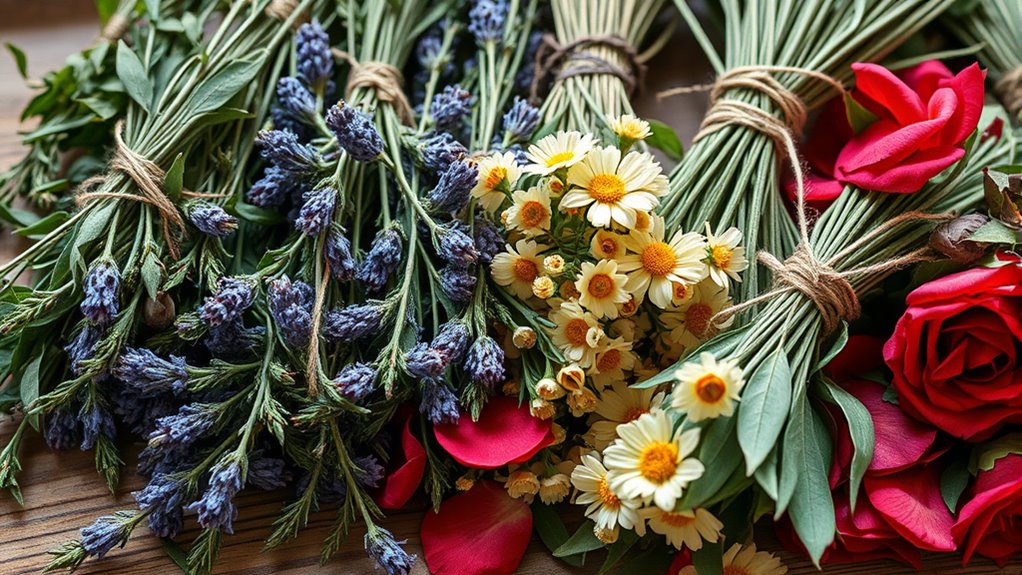
Mastering the art of drying herbs and flowers is essential to preserve their vibrant colors, fragrances, and medicinal qualities. Proper drying techniques support herbal preservation and enhance botanical aesthetics. To achieve ideal results, consider these methods:
| Method | Best For | Tips |
|---|---|---|
| Air drying | Flowers, herbs with sturdy stems | Hang upside down in a dark, dry space |
| Oven drying | Small batches, quick results | Use low heat (around 100°F) |
| Microwave drying | Small quantities | Short bursts, monitor closely |
| Silica gel | Delicate flowers | Fully submerge for quick drying |
| Dehydrator | Large batches | Follow manufacturer directions |
Choose a method based on your herbs’ properties, ensuring botanical aesthetics and herbal preservation shine through. Additionally, proper storage after drying is crucial to maintain their qualities over time.
Essential Tools and Supplies for Herbal Crafting
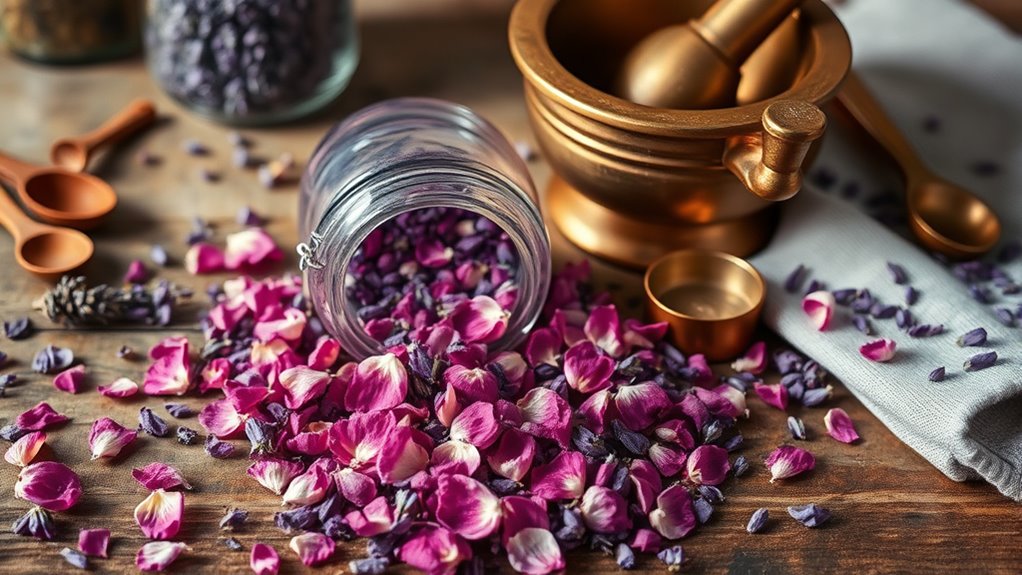
Having the right tools and supplies on hand makes herbal crafting more enjoyable and efficient. You’ll need basic items like scissors for harvesting, glass jars or containers for herb storage, and fine mesh sieves for sifting dried herbs. A good mortar and pestle helps grind herbs to your desired consistency, while labels with botanical nomenclature ensure proper identification and organization. Keep small funnels and droppers for precise measurements when creating extracts or infusions. Quality storage options prevent moisture and light from degrading your herbs’ potency. Additionally, a digital scale ensures accurate measurements, and airtight containers preserve freshness. With these essential tools, you’ll streamline your herbal projects and confidently craft with dried herbs and flowers, knowing everything is properly stored and accurately identified.
Creating Herbal Infusions and Tinctures
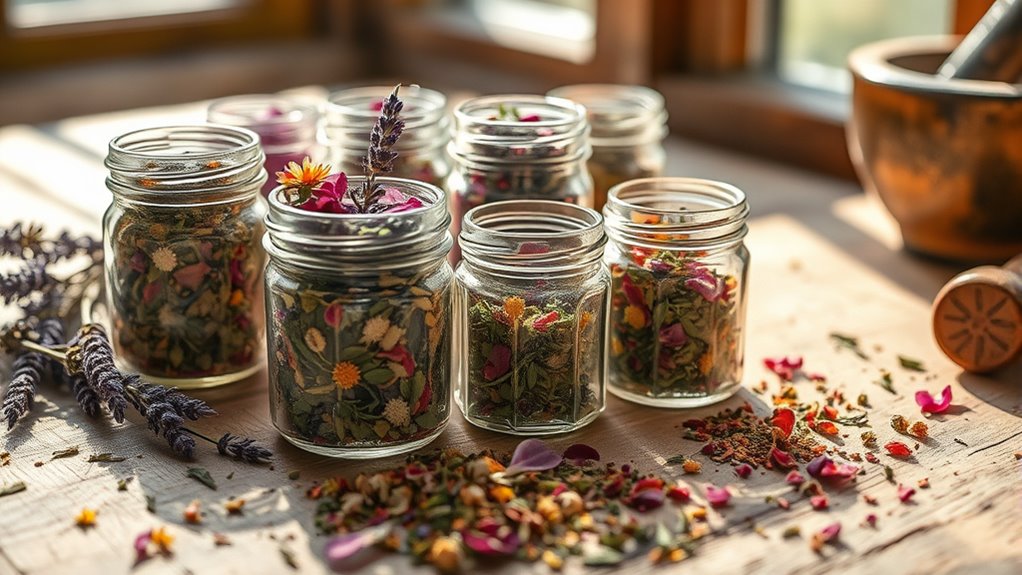
Creating herbal infusions and tinctures is a straightforward way to extract the beneficial properties of dried herbs and flowers. These methods emphasize herbal synergy, where different plants work together to enhance their effects. When selecting herbs, consider flower symbolism to align your creations with your intentions, such as lavender for calm or rose for love. To make infusions or tinctures, you can:
- Use a quality glass jar with a tight lid
- Choose fresh or dried herbs and flowers
- Fill the jar with alcohol or oil for tinctures, or hot water for infusions
- Store in a cool, dark place and shake regularly
This process preserves the plant’s essence and allows you to create personalized herbal remedies that resonate with your goals.
Crafting Potpourri and Sachets
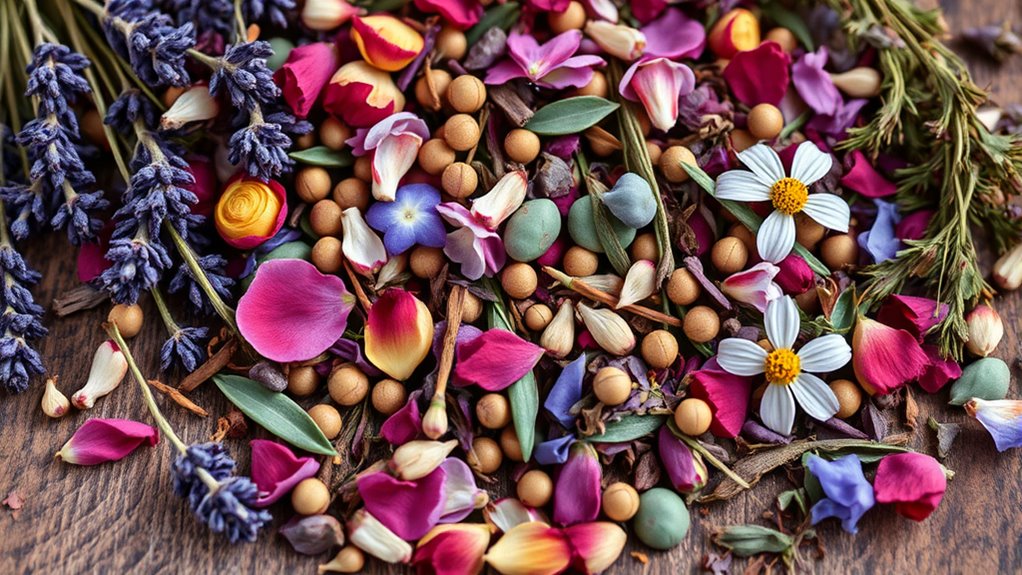
When crafting potpourri and sachets, you select aromatic herbs that will fill your space with lovely scents. Combining fragrant flowers adds depth and complexity to your blends, making them more enjoyable. Proper drying techniques guarantee your herbs and flowers retain their aroma and color for long-lasting freshness. Using low light office plants as inspiration, ensure your herbs are dried in a suitable environment to preserve their scent and vibrancy. Additionally, controlling humidity levels during drying can help prevent mold and spoilage, ensuring your herbs remain fragrant and visually appealing. Paying attention to air circulation can also accelerate the drying process and improve the quality of your herbs. Incorporating merchant services can streamline the sale of your handcrafted items, making it easier for customers to purchase your fragrant creations. Understanding the risks in merchant services can help you choose reliable payment options that protect your sales and customer data.
Selecting Aromatic Herbs
To craft aromatic potpourri and sachets that smell delightful, selecting the right herbs is essential. You want to focus on aromatic herb varieties that create appealing herbal scent profiles. Consider herbs like lavender for a calming aroma, rosemary for a fresh, herbaceous scent, lemon balm for a bright citrus note, and thyme for a subtle earthiness. When choosing herbs, think about the mood you want to evoke and how the scents will blend. Mixing herbs with complementary scent profiles enhances the overall fragrance. Keep in mind that some herbs may lose their scent over time, so select those with strong, lasting aromas. Experimenting with different combinations allows you to craft personalized, fragrant creations that fill your space with delightful natural aromas.
Combining Fragrant Flowers
Combining fragrant flowers is a key step in crafting potpourri and sachets that release a lovely, natural aroma. To create appealing fragrant flower combinations, consider how different blooms’ floral scent pairing complements each other. Mix flowers with varying strengths—such as fragrant roses with milder lavender—to achieve a balanced scent profile. Think about the mood you want to evoke; vibrant, citrusy blooms bring energy, while soft, sweet florals create calmness. Experiment with contrasting textures and colors to enhance visual appeal alongside aroma. Keep in mind that certain floral scent pairing can intensify or mellow each other, so test small batches first. By thoughtfully combining fragrant flowers, you craft a harmonious blend that fills your space with delightful, natural fragrance.
Proper Drying Techniques
Proper drying techniques are essential to preserve the fragrance, color, and texture of your herbs and flowers for potpourri and sachets. To do this, make sure you control humidity levels to prevent mold and loss of aroma. Use a well-ventilated drying chamber or a dark, dry space with good airflow. Here are some tips:
- Hang herbs and flowers upside down in small bundles
- Maintain low humidity to prevent mold growth
- Keep temperature moderate, avoiding direct sunlight
- Check frequently for dryness and avoid over-drying
Making Herbal Salves and Balms
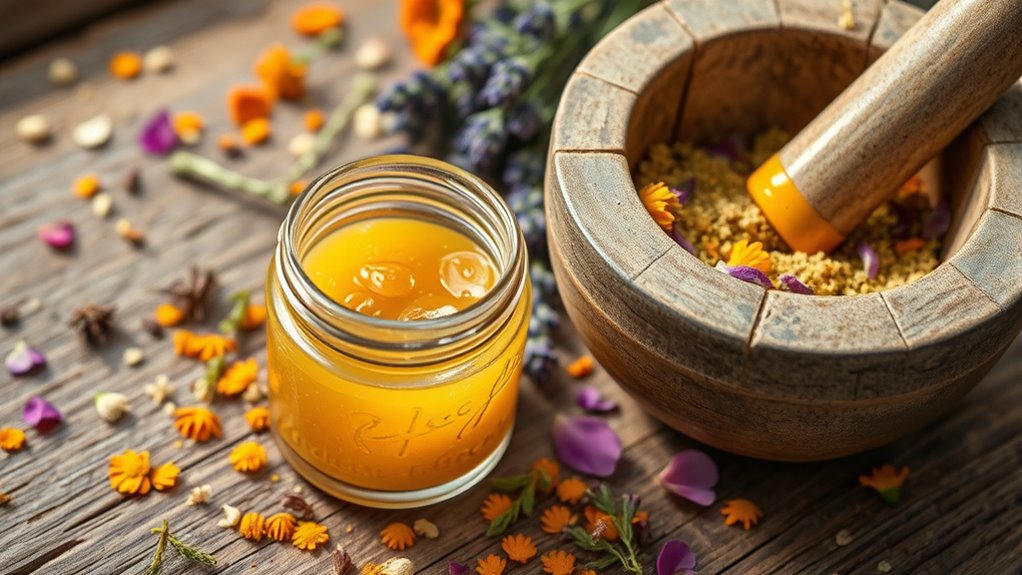
To make effective herbal salves and balms, you need to choose the right base oils, like jojoba or coconut, which will carry the herbal benefits. Infusing these oils with dried herbs and flowers enhances their healing properties and aroma. Once infused, you can mix in beeswax or other solidifiers to create a smooth, easy-to-apply balm.
Selecting Base Oils
Choosing the right base oil is essential for creating effective herbal salves and balms. Your choice influences consistency, absorption, and herbal safety. Take into account the properties of different oils to match your intent and skin type. For example, carrier oils like jojoba or almond are gentle and nourishing, while coconut oil provides a solid texture. Keep in mind that some oils can interfere with botanical dyes or herbal safety, so test small batches first.
Here are some options to consider:
- Jojoba oil, for long shelf life and skin compatibility
- Almond oil, for lightweight moisturization
- Coconut oil, for a firm texture and antimicrobial properties
- Olive oil, for a rich, penetrative base
Selecting the right oil ensures your herbal salves are both effective and safe.
Infusing Herbal Extracts
Infusing herbal extracts is an essential step in making herbal salves and balms, as it allows you to extract the beneficial properties of herbs into your chosen base oil. This process, known as herbal extraction, involves creating a botanical infusion where herbs steep in oil to transfer their active compounds. To begin, gently heat your dried herbs with the oil, maintaining a low temperature to preserve potency. Alternatively, you can let the herbs sit in the oil for several weeks in a warm, dark place, allowing a slow extraction. Stir or shake the mixture regularly to encourage even infusion. Once the botanical infusion is complete, strain out the herbs, leaving you with a potent herbal extract ready for your salve or balm.
Designing Dried Flower Arrangements and Decor
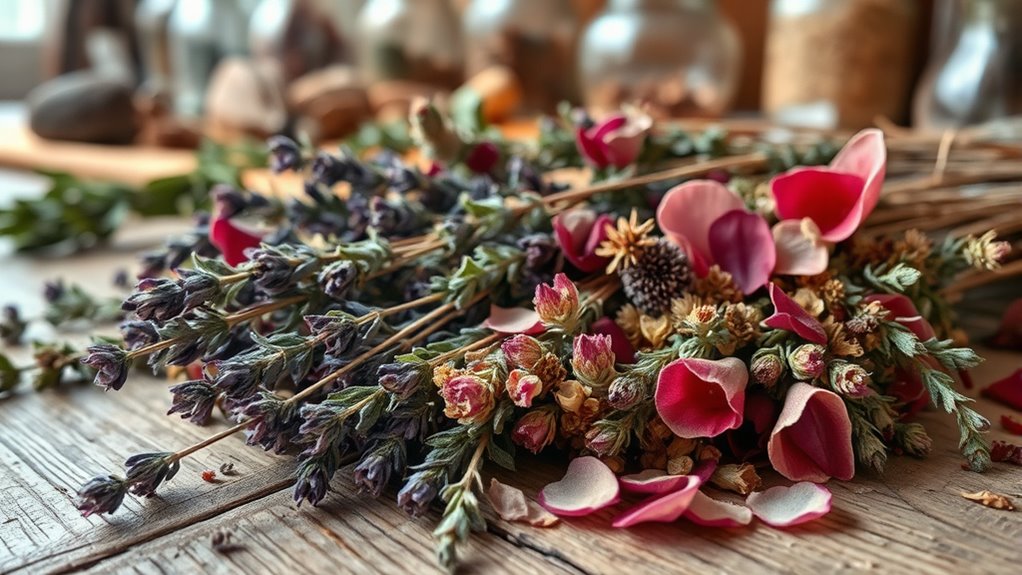
Creating dried flower arrangements and decor offers a timeless way to bring natural beauty into your space. When designing floral arrangements, consider your chosen color schemes to create harmony and mood. Think about mixing textures and shapes for visual interest, from delicate blooms to sturdy stems. Use simple containers like vintage jars or rustic baskets to enhance the natural feel. To make your decor stand out, try grouping similar colors or contrasting shades for bold effects. Incorporate dried herbs or foliage for added depth and fragrance. Remember, balance and proportion matter—avoid overcrowding. Utilizing vetted supplies from trusted sources ensures your arrangements are both beautiful and durable. This approach guarantees your floral arrangements become focal points that reflect your style and personality, transforming any room into a calming, botanical retreat.
Incorporating Herbs Into Candles and Soaps
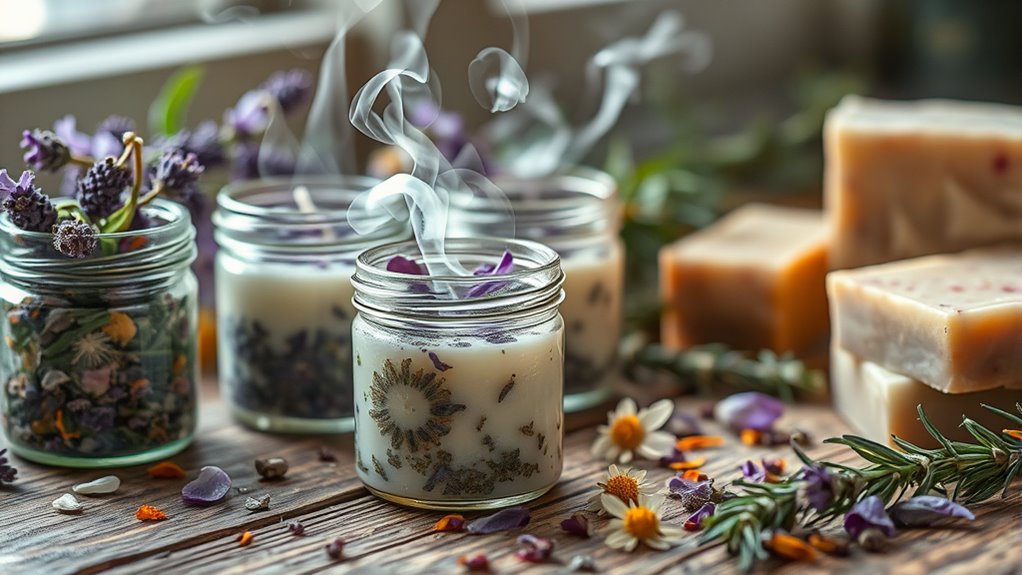
Adding herbs to candles and soaps is an effective way to infuse your homemade products with natural scents and visual appeal. When you incorporate herbs thoughtfully, you harness herbal synergy, where the combined qualities of the herbs enhance the overall effect. For example, lavender promotes relaxation, while rosemary energizes, allowing you to tailor your creations to specific moods or intentions. Additionally, understanding botanical symbolism adds depth; herbs like thyme symbolize courage, making your candles or soaps meaningful gifts. To maximize benefits, embed dried herbs evenly for aesthetic appeal and scent distribution. Be mindful of the herbs’ properties, scent strength, and appearance, ensuring each piece resonates with your desired purpose. This approach elevates your craft, blending beauty, symbolism, and natural healing, which can also support your meditative practice by creating a calming environment. Incorporating AI-powered tools can assist in selecting herbs that align with specific intentions or energies, enhancing your creative process.
Tips for Preserving and Storing Your Creations
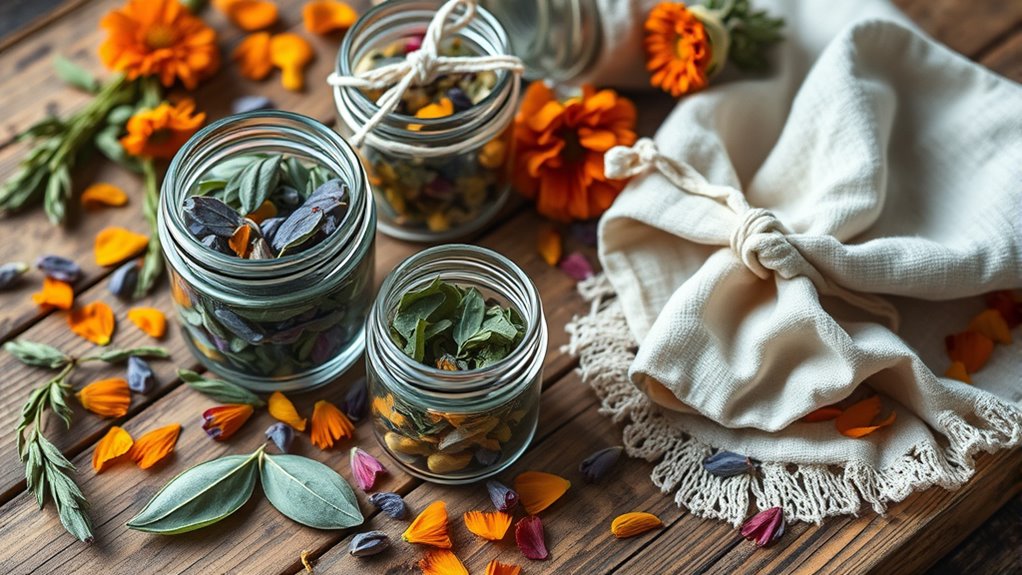
Proper preservation and storage are essential to maintain the beauty, scent, and longevity of your dried herbs and flowers. To maximize shelf life, choose airtight storage containers that protect against moisture, light, and air exposure. Keep your creations in a cool, dark place to prevent deterioration. Label your containers with the contents and date to track freshness. Avoid overcrowding, which can bruise delicate petals and leaves. Regularly check for signs of mold or fading, and replace items as needed. Consider using glass jars or metal tins for long-term storage, as they offer better protection. Properly stored, your dried herbs and flowers can stay vibrant and fragrant for months, ensuring your crafting projects remain fresh and beautiful. Additionally, storage techniques such as using silica gel packets can help control humidity levels and preserve your botanicals’ quality over time. Implementing performance tuning strategies can also enhance the overall quality of your preservation process. Utilizing air purifiers with HEPA filtration can reduce airborne contaminants that might cause mold or spoilage during storage. Incorporating mindset principles from the Law of Attraction can help you maintain a positive attitude toward your creative projects and attract abundance in your crafting endeavors.
Frequently Asked Questions
How Do I Identify the Best Herbs and Flowers for Herbal Alchemy?
To identify the best herbs and flowers for your projects, focus on botanical identification by examining their leaves, stems, and flowers carefully. Use reputable herbal sourcing sources like trusted vendors, local farmers, or wildcrafting guides to verify quality. Trust your senses—smell, touch, and appearance—and cross-reference with reliable plant guides. Proper identification guarantees safe, effective herbs, making your herbal alchemy practice more successful and enjoyable.
Can Dried Herbs Retain Their Medicinal Properties Over Time?
Did you know that properly dried herbs can retain up to 85% of their herbal potency for years? Dried herbs do keep their medicinal properties over time if stored correctly. To maximize storage longevity, keep herbs in airtight containers away from light, heat, and moisture. This prevents the loss of essential oils and active compounds, ensuring your herbs remain effective for future use and your herbal alchemy projects.
What Are Common Mistakes to Avoid in Herbal Drying Processes?
When drying herbs, avoid common mistakes like improper herb storage and poor drying techniques. You should guarantee herbs are fully dried before storage to prevent mold, and use appropriate methods like air drying or low heat to preserve potency. Keep herbs in airtight containers away from sunlight, moisture, and heat. By paying attention to drying techniques and herb storage, you’ll maintain flavor, aroma, and medicinal properties longer.
How Can I Safely Combine Different Herbs for Unique Formulations?
To safely combine herbs for unique formulations, you should consider herbal synergy, where certain herbs enhance each other’s effects, creating a balanced blend. Always research each herb’s properties and potential toxicity to prevent adverse reactions. Start with small amounts, test the combination, and observe how your body responds. This approach helps you craft effective, safe herbal remedies while minimizing risks related to toxicity and ensuring harmonious blends.
Are There Eco-Friendly Methods for Disposing of Herbal Waste?
Think of herbal waste disposal as tending a garden; you want to keep it healthy and thriving. You can adopt eco-friendly methods like composting practices to return nutrients to the earth naturally. Herbal waste recycling is another great option—use dried herbs in homemade potpourri or herbal teas. These practices reduce waste, protect the environment, and promote sustainability, making your herbal crafts even more eco-conscious and rewarding.
Conclusion
As you journey deeper into herbal alchemy, you’ll find your creations becoming timeless whispers of nature’s subtle poetry. Embrace each carefully crafted piece as a gentle invitation to harmony and beauty, woven through your hands and heart. With patience and passion, your botanical artistry will flourish, offering quiet elegance and enduring charm. Trust in this delicate dance, and let your botanical treasures softly echo the secret language of the earth.
